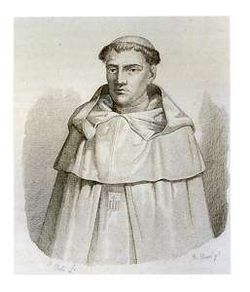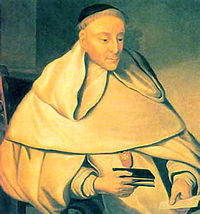
Tirso de Molina
Encyclopedia

Spain
Spain , officially the Kingdom of Spain languages]] under the European Charter for Regional or Minority Languages. In each of these, Spain's official name is as follows:;;;;;;), is a country and member state of the European Union located in southwestern Europe on the Iberian Peninsula...
Baroque
Spanish Baroque literature
Spanish Baroque literature is the literature written in Spain during the Baroque.The literary Baroque took place in Spain in the middle of the Golden Age of Spanish Literature. Spain was governed in that period by Philip II, Philip III and Philip IV, the last reigning until 1665.During the previous...
dramatist, poet and a Roman Catholic monk.
Originally Gabriel Téllez, he was born in Madrid
Madrid
Madrid is the capital and largest city of Spain. The population of the city is roughly 3.3 million and the entire population of the Madrid metropolitan area is calculated to be 6.271 million. It is the third largest city in the European Union, after London and Berlin, and its metropolitan...
. He studied at Alcalá de Henares
University of Alcalá
The University of Alcalá is a public university located in Alcalá de Henares, a city 35 km northeast of Madrid in Spain. Founded in 1499, it was moved in 1836 to Madrid. In 1977, the University was reopened in its same historical buildings...
, joined the Order of the Blessed Virgin Mary of Mercy
Order of the Blessed Virgin Mary of Mercy
The Royal, Celestial and Military Order of Our Lady of Mercy and the Redemption of the Captives also known as Our Lady of Ransom is a Roman Catholic religious order established in 1218 by St...
on November 4, 1600, and entered the Monastery of San Antolín at Guadalajara, Spain
Guadalajara, Spain
Guadalajara is a city and municipality in the autonomous community of Castile-La Mancha, Spain, and in the natural region of La Alcarria. It is the capital of the province of Guadalajara. It is located roughly 60 km northeast of Madrid on the Henares River, and has a population of 83,789...
on January 21, 1601. He was ordained a priest by 1610.
He had been writing plays for ten years when he was sent by his superiors on a mission to the West Indies in 1615; returning to Europe in 1617, he resided at the Mercedarian monastery in Madrid, took part in the proceedings of the Academía poetica de Madrid, founded by Sebastian Francisco de Medrano, competed in the literary tournaments then in vogue, and wrote copiously for the stage.
His first publication, the incomplete Cigarrales de Toledo (licensed in 1621, but not published till 1624), is a miscellany, containing short tales, novels, verses and three plays. One of the novels, Los Tres maridos burlados, probably derived from Francesco Cieco da Ferrara's Mambriano, and the play entitled El Vergonzoso en palacio reveal his wit and ingenuity. The preface to the Cigarrales de Toledo states that Tirso de Molina had already written three hundred plays, and at this period of his career he was second only to his friend Lope de Vega in popularity.
He showed hostility to culteranismo in the Cigarrales de Toledo, and made numerous enemies by his attacks on the new school in such pieces as Amar por arte mayor and La Celosa de si misma. The realistic character of some of his productions gave his rivals an excuse to denounce him as a corrupter of public morals to the council of Castile in 1625, and, though no legal action was taken against him, he appears to have been reprimanded privately. In 1626 it was thought advisable to transfer him to Salamanca
Salamanca
Salamanca is a city in western Spain, in the community of Castile and León. Because it is known for its beautiful buildings and urban environment, the Old City was declared a UNESCO World Heritage Site in 1988. It is the most important university city in Spain and is known for its contributions to...
, and Tirso de Molina left Madrid determined to write no more for the stage. Though one of his plays, La Huerta de San Juan, is dated 1626, there is no proof that it was begun after his departure from Madrid, and he seems to have written nothing for eight years.
He had not lost his interest in the theatre, and published twelve representative pieces as the first part of his dramatic works (1626). This was a formal protest against the weakness of those who had been persuaded to drive him out. On the other hand, he worked zealously on behalf of his order, and rose to an important position; he became superior of the monastery at Trujillo in 1626, was elected later to the posts of reader in theology and definidor general, and in May 1632 was appointed chronicler of the Order of Mercy. His Deleitar aprovechando (1635) is a devout counterpart of the Cigarrales de Toledo, much inferior to its predecessor in interest; a sequel was promised to this collection of pious tales, pious lyrics, and autos, but, as in the case of the Cigarrales de Toledo, the continuation never appeared.

Juan Ruiz de Alarcón
Juan Ruiz de Alarcón y Mendoza , one of the greatest Novohispanic dramatists of the Golden Age, was born in New Spain .-Genealogy:...
, but Tirso de Molina was the predominant spirit in these literary partnerships. The fourth and fifth parts of his dramatic works (1635 and 1636) each contain twelve plays; the haste with which these five volumes were issued indicates the author's desire to save some part of his work from destruction, and the appearance of his "nephew"'s name on the title-pages of the last four volumes indicates his desire to avoid conflict with the authorities. A sixth volume of dramatic pieces, consisting of light comedies, was announced; but the project was abandoned. That dramatic composition still entertained the scanty leisure of Tirso's old age is shown by the fact that the fragmentary autograph copy of Las Quinas de Portugal is dated March 8, 1638; but his active career as a dramatist ended two years earlier. He was absorbed by other duties. As official chronicler of his order, he compiled the elaborate Historia de la merced, which occupied him till December 24, 1639, and still survives in manuscript. As a tribute to the count de Sastago, who had accepted the dedication of the fourth part of the plays, and who had probably helped to defray the publishing expenses, Tirso de Molina is said to have compiled the Genealogía de la casa de Sastago (1640), but the ascription of this genealogical work is disputed. On September 29, 1645 Tirso de Molina became superior of the monastery at Soría
Soria
Soria is a city in north-central Spain, the capital of the province of Soria in the autonomous community of Castile and León. , the municipality has a population of c. 39,500 inhabitants, nearly 40% of the population of the province...
, and died there.
_01.jpg)
Don Juan
Don Juan is a legendary, fictional libertine whose story has been told many times by many authors. El burlador de Sevilla y convidado de piedra by Tirso de Molina is a play set in the fourteenth century that was published in Spain around 1630...
is first presented on the stage; but El Burlador de Sevilla represents only one aspect of his genius. No less remarkable than his representation of perverse depravity in El Burlador de Sevilla is his dramatic treatment of a philosophical enigma in El Condenado por desconfiado, but El Burlador de Sevilla and El Condenado por desconfiado are thought by scholars as Fernando Cantalapiedra or Alfredo Rodriguez to have been written by Andrés de Claramonte
Andrés de Claramonte
Andrés de Claramonte y Corroy was a playwright of the Spanish Golden Age.Very little facts are known about his life. As an actor, he worked for the most important companies, such as Baltasar de Pinedo's or Alonso de Olmedo's...
. Though manifestly attracted by exceptional cases, by every kind of moral aberration, by the infamous and the terrible, his range is virtually unlimited. He reveals himself as a master of historical interpretation in La Prudencia de la mujer; his sympathetic, malicious wit finds dramatic expression in El Vergonzoso en palacio and Don Gil de las calzas verdes, and the fine divination of feminine character in Averígüelo, Vargas and La Villana de Vallecas (The peasant woman of Vallecas) is incomparable.
Tirso de Molina has neither Lope de Vega's inventive resource, nor his infinite seduction; he has neither Calderón
Pedro Calderón de la Barca
Pedro Calderón de la Barca y Barreda González de Henao Ruiz de Blasco y Riaño usually referred as Pedro Calderón de la Barca , was a dramatist, poet and writer of the Spanish Golden Age. During certain periods of his life he was also a soldier and a Roman Catholic priest...
's idealistic visions, nor his golden music; but he exceeds Lope in massive intellectual power and in artistic self-restraint, and he exceeds Calderón in humour, in creative faculty, and in dramatic intuition. That his reputation extended beyond the Pyrenees in his own lifetime may be gathered from the fact that James Shirley
James Shirley
James Shirley was an English dramatist.He belonged to the great period of English dramatic literature, but, in Lamb's words, he "claims a place among the worthies of this period, not so much for any transcendent genius in himself, as that he was the last of a great race, all of whom spoke nearly...
's Opportunity is derived from El Castigo del penséque; but he was neglected in Spain itself during the long period of Calderón's supremacy, and his name was almost forgotten till the end of the 18th century, when some of his pieces were timidly recast by Dionisio Solis and later by Juan Carretero.
The renaissance of his fame, however, dates from 1839–1842, when an incomplete but serviceable edition of his plays was published by Juan Eugenio Hartzenbusch
Juan Eugenio Hartzenbusch
Juan Eugenio Hartzenbusch , was a Spanish dramatist. He was the Director of the National Library of Spain until he retired in 1875.-Biography:...
. He is now accepted as among the greatest dramatists of Spain.

